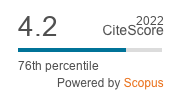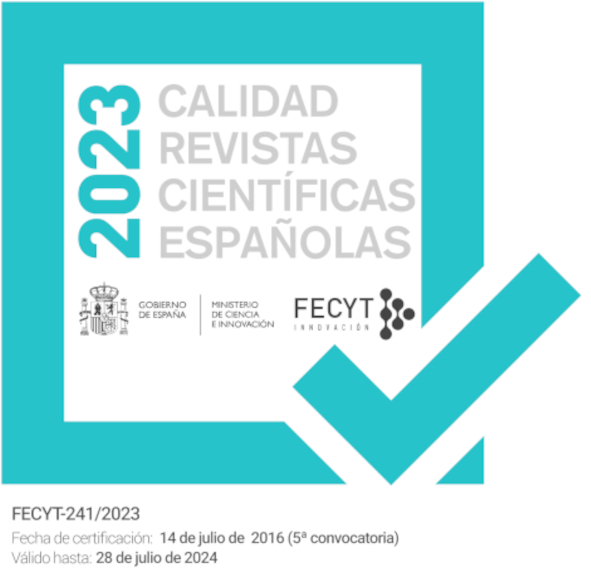Soil erosion triggered by the archeological excavation and conservation of trenches. The case of “Cerro de las Trincheras” in Bailén (Jaén, Spain)
An open discussion
DOI:
https://doi.org/10.18172/cig.5746Keywords:
trenches, soil conservation, land management, archeology, gullies, erosionAbstract
Gully erosion is a landform developed due to accelerated soil erosion rates. Gullies can be identified by human impacts on geomorphological processes, as well as hydrological and erosional systems. In Spain, the trenches or "trincheras" from the Spanish Civil War (1936-1939) are considered of archaeological interest for several reasons. At Cerro de las Trincheras in Bailén (Jaén, Spain), a trench was built during the Spanish Civil War. In 2020, an archaeological excavation took place to restore the ruins, triggering the development of gullies and rills and a decrease in vegetation quality. We present a first approximation of the variations in vegetation cover and the decrease in quality (using NDVI, the normalized difference vegetation index) due to the trench acting as a gully (1956, 2005-2020) and the increase in rills and gullies after the excavation. We strongly advocate for future archaeological excavations to include a protocol (soil mapping, vegetation survey, and hydrological connectivity index) to reduce soil degradation and prevent damage to vegetation and associated ecosystems, thereby curbing the increase in soil erosion rates.
Downloads
References
Abdo, H.G., 2018. Impacts of war in Syria on vegetation dynamics and erosion risks in Safita area, Tartous, Syria. Reg. Environ. Change 18, 1707-1719. https://doi.org/10.1007/s10113-018-1280-3
Almohamad, H., 2020. Impact of Land Cover Change Due to Armed Conflicts on Soil Erosion in the Basin of the Northern Al-Kabeer River in Syria Using the RUSLE Model. Water 12, 3323. https://doi.org/10.3390/w12123323
Amare, S., Keesstra, S., van der Ploeg, M., Langendoen, E., Steenhuis, T., Tilahun, S., 2019. Causes and Controlling Factors of Valley Bottom Gullies. Land 8, 141. https://doi.org/10.3390/land8090141
Arabameri, A., Cerda, A., Tiefenbacher, J.P., 2019. Spatial Pattern Analysis and Prediction of Gully Erosion Using Novel Hybrid Model of Entropy-Weight of Evidence. Water 11, 1129. https://doi.org/10.3390/w11061129
Barnett, A.P., Diseker, E.G., Richardson, E.C., 1967. Evaluation of mulching methods for erosion control on newly prepared and seeded highway backslopes. Agron. J. 59, 83-85. https://doi.org/10.2134/agronj1967.00021962005900010026x
Bocco, G., 1991. Gully erosion: processes and models. Prog. Phys. Geogr. Earth Environ. 15, 392-406. https://doi.org/10.1177/030913339101500403
Casalí, J., López, J.J., Giráldez, J.V., 2003. A process-based model for channel degradation: application to ephemeral gully erosion. Catena 50, 435-447. https://doi.org/10.1016/S0341-8162(02)00127-3
Castillo, C., Pérez, R., James, M.R., Quinton, J.N., Taguas, E.V., Gómez, J.A., 2012. Comparing the accuracy of several field methods for measuring gully erosion. Soil Sci. Soc. Am. J. 76, 1319-1332. https://doi.org/10.2136/sssaj2011.0390
De Ploey, J., 1991. Gullying of drainage basins: analysis and predictions made by the Es model. Bull. Soc. Geogr. Liege 27, 69-76.
Delgado, M.M., 2015. Memory, Silence, and Democracy in Spain: Federico García Lorca, the Spanish Civil War, and the Law of Historical Memory. Theatre J. 67, 177-196.
Dmytruk, Y., Cherlinka, V., Cherlinka, L., Dent, D., 2023. Soils in war and peace. Int. J. Environ. Stud. 80, 380-393. https://doi.org/10.1080/00207233.2022.2152254
Dunkley, R., Morgan, N., Westwood, S., 2011. Visiting the trenches: Exploring meanings and motivations in battlefield tourism. Tour. Manag. 32, 860-868. https://doi.org/10.1016/j.tourman.2010.07.011
Evans, S.Z., 2021. The Removal of Confederate Monuments: Reflections on Power and Privilege in Shared Spaces. Soc. Sci. Q. 102, 1044-1055. https://doi.org/10.1111/ssqu.12965
Ferrándiz, F., 2019. Unburials, Generals, and Phantom Militarism: Engaging with the Spanish Civil War Legacy. Curr. Anthropol. 60, S62-S76. https://doi.org/10.1086/701057
Fini, A., Frangi, P., Mori, J., Donzelli, D., Ferrini, F., 2017. Nature based solutions to mitigate soil sealing in urban areas: Results from a 4-year study comparing permeable, porous, and impermeable pavements. Environ. Res. 156, 443-454. https://doi.org/10.1016/j.envres.2017.03.032
Gilbert, M., 2016. La Primera Guerra Mundial. 15a Edición Aniversario. Madrid.
Gómez-Gutiérrez, Á., Schnabel, S., Felicísimo, A.M., 2009. Modelling the occurrence of gullies in rangelands of southwest Spain. Earth Surf. Process. Landf. 34, 1894-1902. https://doi.org/10.1002/esp.1881
González-Ruibal, A., 2007. Making things public: Archaeologies of the Spanish Civil War. Public Archaeol. 6, 203-226. https://doi.org/10.1179/175355307X264165
Gonzalez Ruibal, A., 2023. Tierra arrasada: Un viaje por la violencia del Paleolítico al siglo XXI. Crítica. Barcelona.
Hutchinson, D.J., Diederichs, M., Pehme, P., Sawyer, P., Robinson, P., Puxley, A., Robichaud, H., 2008. Geomechanics stability assessment of World War I military excavations at the Canadian National Vimy Memorial Site, France. Int. J. Rock Mech. Min. Sci. 45, 59-77. https://doi.org/10.1016/j.ijrmms.2007.04.014
Keesstra, S., Nunes, J., Novara, A., Finger, D., Avelar, D., Kalantari, Z., Cerdà, A., 2018. The superior effect of nature based solutions in land management for enhancing ecosystem services. Sci. Total Environ. 610-611, 997-1009. https://doi.org/10.1016/j.scitotenv.2017.08.077
Kiernan, K., 2015. Nature, Severity and Persistence of Geomorphological Damage Caused by Armed Conflict. Land Degrad. Dev. 26, 380-396. https://doi.org/10.1002/ldr.2216
Kirkby, M.J., Bracken, L.J., 2009. Gully processes and gully dynamics. Earth Surf. Process. Landf. 34, 1841-1851. https://doi.org/10.1002/esp.1866
Labanyi, J., 2007. Memory and Modernity in Democratic Spain: The Difficulty of Coming to Terms with the Spanish Civil War. Poet. Today 28, 89-116. https://doi.org/10.1215/03335372-2006-016
López Martínez, J.J., Moreno Oronato, A., Arboleda Martínez, L., Padilla Fernández, J.J., 2020. Puesta en valor del patrimonio histórico y natural del Monte público de Burguillos (Bailén, Jaén). Locuber 25-39.
Marshall, M.T., Petrelli, D., Dulake, N., Not, E., Marchesoni, M., Trenti, E., Pisetti, A., 2016. Audio-based narratives for the trenches of World War I: Intertwining stories, places and interaction for an evocative experience. Int. J. Hum.-Comput. Stud., Data Sonification and Sound Design in Interactive Systems 85, 27-39. https://doi.org/10.1016/j.ijhcs.2015.08.001
Merino Chica, J.A., 2021. Estructuras defensivas de la Guerra Civil Española en la localidad de Bailén (Jaén). (Final degree thesis). University of Granada, Granada.
Nadal-Romero, E., Petrlic, K., Verachtert, E., Bochet, E., Poesen, J., 2014. Effects of slope angle and aspect on plant cover and species richness in a humid Mediterranean badland. Earth Surf. Process. Land. 39, 1705-1716. https://doi.org/10.1002/esp.3549
Owley, J., Phelps, J., 2018. Understanding the Complicated Landscape of Civil War Monuments. Indiana Law J. Suppl. 93, 15.
Prosser, I.P., Soufi, M., 1998. Controls on gully formation following forest clearing in a humid temperate environment. Water Resour. Res. 34, 3661-3671. https://doi.org/10.1029/98WR02513
Rawtani, D., Gupta, G., Khatri, N., Rao, P.K., Hussain, C.M., 2022. Environmental damages due to war in Ukraine: A perspective. Sci. Total Environ. 850, 157932. https://doi.org/10.1016/j.scitotenv.2022.157932
Rodrigo-Comino, J., Wirtz, S., Brevik, E.C., Ruiz-Sinoga, J.D., Ries, J.B., 2017. Assessment of agri-spillways as a soil erosion protection measure in Mediterranean sloping vineyards. J. Mt. Sci. 14, 1009-1022. https://doi.org/10.1007/s11629-016-4269-8
Rodrigo-Comino, J., Senciales, J.M., Cerdà, A., Brevik, E.C., 2018. The multidisciplinary origin of soil geography: A review. Earth-Sci. Rev. 177, 114-123. https://doi.org/10.1016/j.earscirev.2017.11.008
Sheehan, R., Speights-Binet, J., 2019. Negotiating strategies in New Orleans’s memory-work: white fragility in the politics of removing four Confederate-inspired monuments. Journal of Cultural Geography 36, 346-367. https://doi.org/10.1080/ 08873631.2019.1641996
Stebelsky, I., 2015. Soil Management in Ukraine: Responding to Environmental Degradation. Can. Slavon. Pap.
Thestorf, K., Makki, M., 2022. Soils and landforms of war — Pedological investigations 75 years after World War II. Geomorphology 407, 108189. https://doi.org/10.1016/j.geomorph.2022.108189
Valjavec, M.B., Zorn, M., Ribeiro, D., 2018. Mapping War Geoheritage: Recognising Geomorphological Traces of War. Open Geosci. 10, 385-394. https://doi.org/10.1515/geo-2018-0030
Vanwalleghem, T., Poesen, J., Nachtergaele, J., Verstraeten, G., 2005. Characteristics, controlling factors and importance of deep gullies under cropland on loess-derived soils. Geomorphology 69, 76-91. https://doi.org/10.1016/j.geomorph.2004.12.003
Waga, J.M., Szypuła, B., Fajer, M., 2022. Heritage of War: Analysis of Bomb Craters Using Lidar (kędzierzyn-Koźle, Poland) 593-608.
Downloads
Published
How to Cite
Issue
Section
License
Copyright (c) 2023 Jesús Rodrigo Comino, Juan Jesús Padilla Fernández, Artemi Cerdà

This work is licensed under a Creative Commons Attribution 4.0 International License.
The authors retain copyright of articles and authorize Cuadernos de Investigación Geográfica / Geographical Research Letters the first publication. They are free to share and redistribute the article without obtaining permission from the publisher as long as they give appropriate credit to the editor and the journal.
Self-archiving is allowed too. In fact, it is recommendable to deposit a PDF version of the paper in academic and/or institutional repositories.
It is recommended to include the DOI number.
This journal is licensed under a Creative Commons Attribution 4.0 International License











